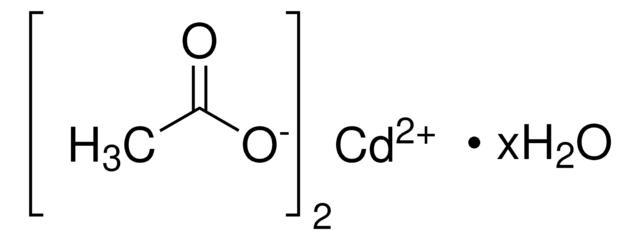642045
Cadmium nitrate tetrahydrate
98%
Sinónimos:
Nitric acid, cadmium salt tetrahydrate
About This Item
Productos recomendados
assay
98%
form
solid
reaction suitability
reagent type: catalyst
core: cadmium
mp
59.5 °C (lit.)
SMILES string
[H]O[H].[H]O[H].[H]O[H].[H]O[H].[O-][N+](=O)O[Cd]O[N+]([O-])=O
InChI
1S/Cd.2NO3.4H2O/c;2*2-1(3)4;;;;/h;;;4*1H2/q+2;2*-1;;;;
InChI key
QOYRNHQSZSCVOW-UHFFFAOYSA-N
¿Está buscando productos similares? Visita Guía de comparación de productos
Categorías relacionadas
signalword
Danger
Hazard Classifications
Acute Tox. 2 Inhalation - Acute Tox. 3 Oral - Acute Tox. 4 Dermal - Aquatic Acute 1 - Aquatic Chronic 1 - Carc. 1B - Muta. 1B - Repr. 1B - STOT RE 1
target_organs
Kidney,Bone
Storage Class
6.1B - Non-combustible acute toxic Cat. 1 and 2 / very toxic hazardous materials
wgk_germany
WGK 3
flash_point_f
Not applicable
flash_point_c
Not applicable
Certificados de análisis (COA)
Busque Certificados de análisis (COA) introduciendo el número de lote del producto. Los números de lote se encuentran en la etiqueta del producto después de las palabras «Lot» o «Batch»
¿Ya tiene este producto?
Encuentre la documentación para los productos que ha comprado recientemente en la Biblioteca de documentos.
Los clientes también vieron
Artículos
The diversity of applications and nanostructured materials accessible using ultrasonic spray methods are highlighted in this article.
Ultrasonic spray pyrolysis produces scalable nanomaterials like metal oxides and quantum dots for diverse applications.
Colloidal quantum dots (CQDs) are semiconducting crystals of only a few nanometers (ca. 2–12 nm) coated with ligand/surfactant molecules to help prevent agglomeration.
Nuestro equipo de científicos tiene experiencia en todas las áreas de investigación: Ciencias de la vida, Ciencia de los materiales, Síntesis química, Cromatografía, Analítica y muchas otras.
Póngase en contacto con el Servicio técnico
















